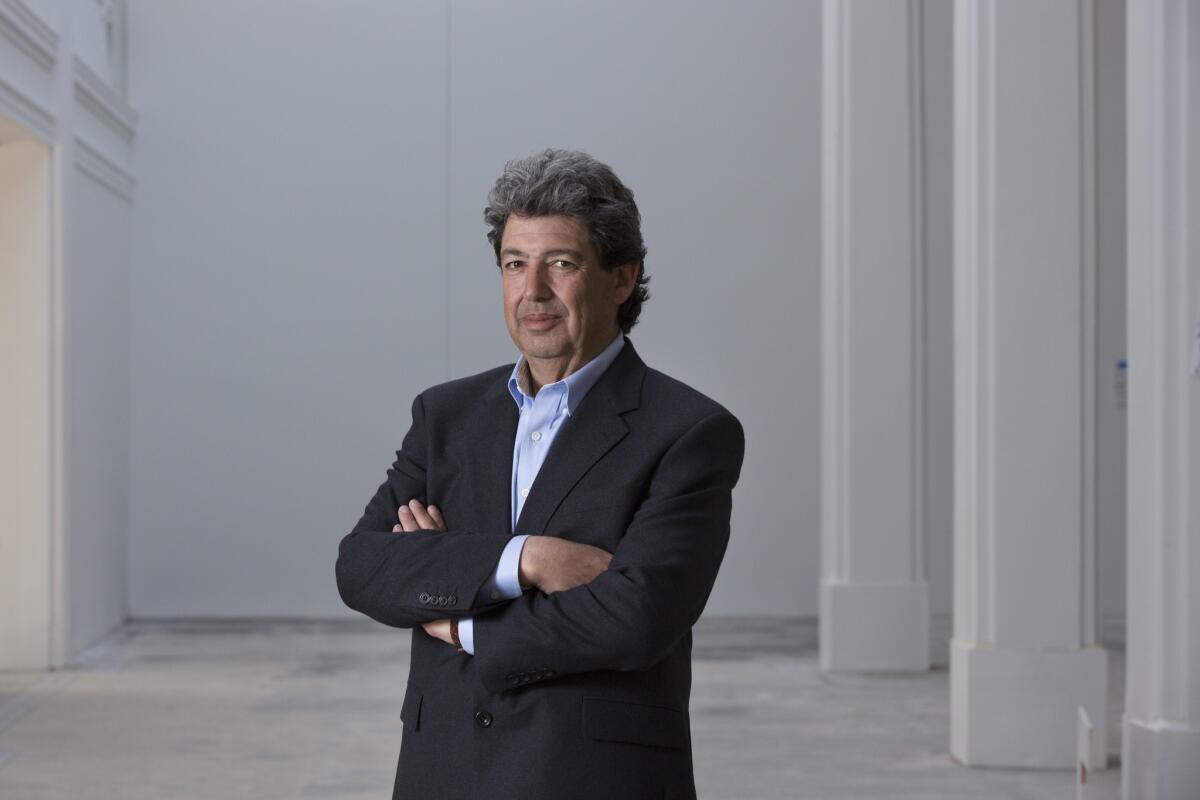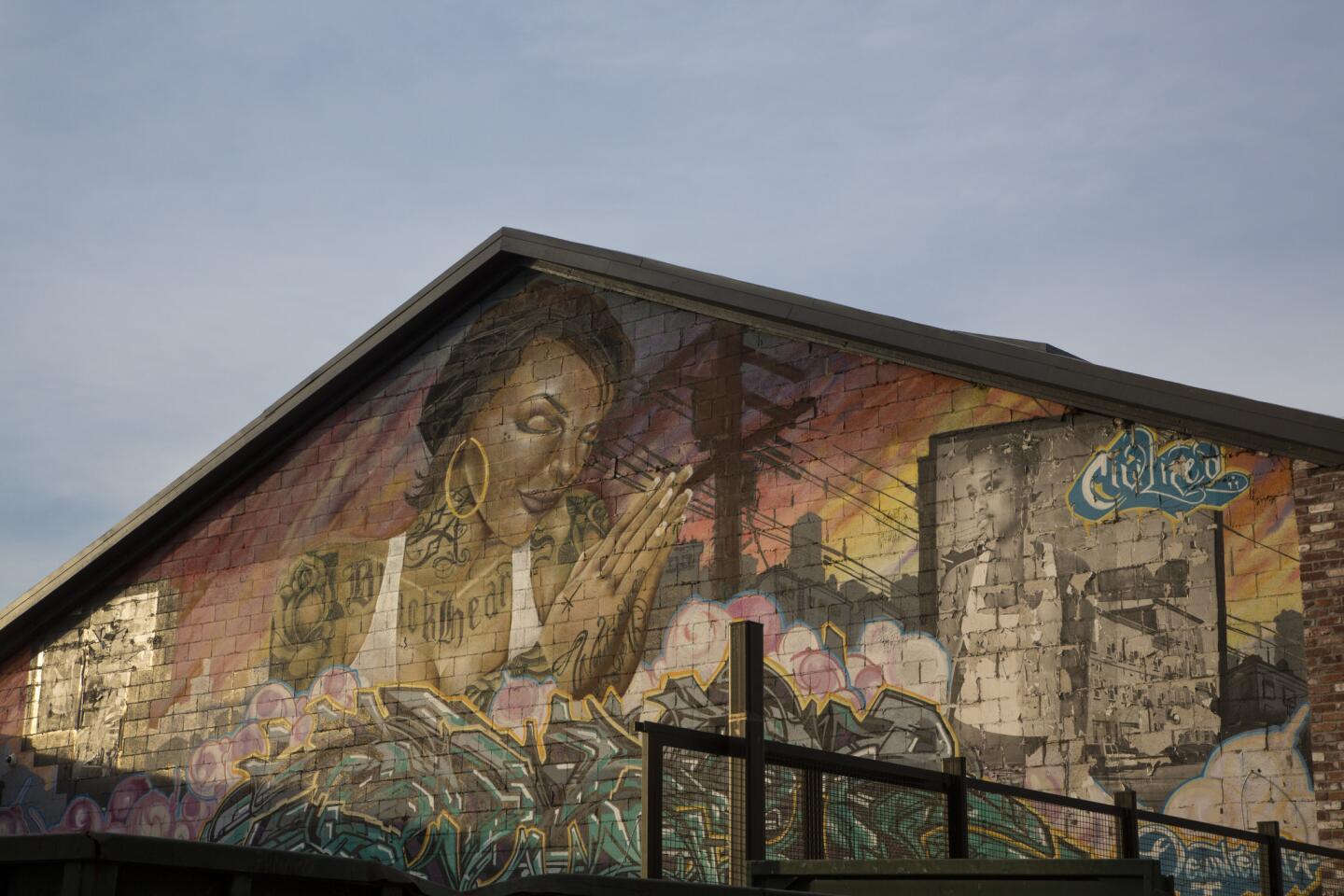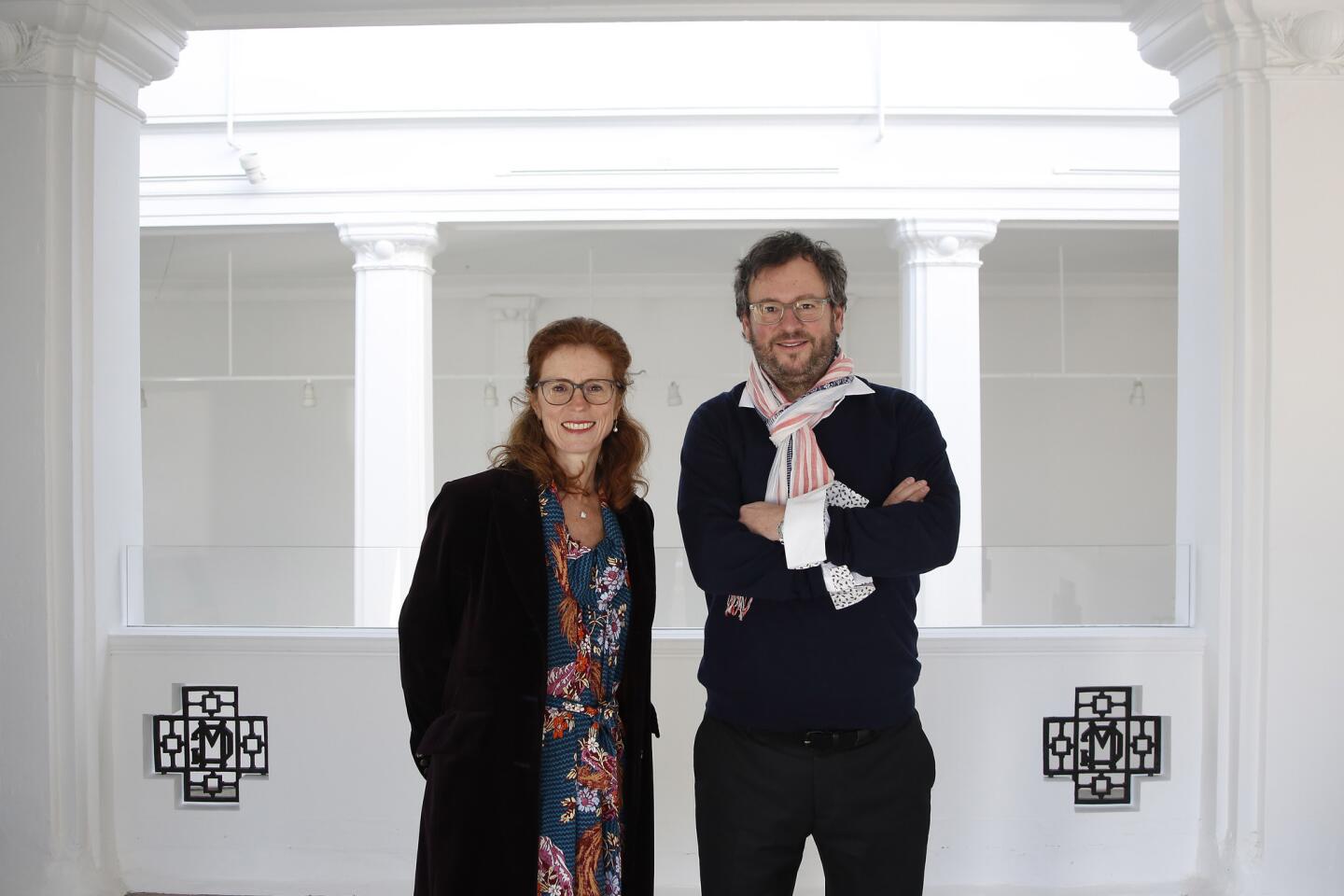L.A.’s Hauser Wirth & Schimmel is out to upend the definition of a gallery

Co-founder Iwan Wirth and partner Manuela Wirth, stand in the Hauser Wirth & Schimmel gallery space in downtown Los Angeles.
It is safe to say that most gallery tours are not conducted by flashlight. But an hour into a walk-through of the massive space that will become the gallery Hauser Wirth & Schimmel, the sun has slipped below the horizon, the temperature has plunged and the industrial stairs that zigzag up the side of the old Pillsbury flour mill complex in downtown Los Angeles are pitch black.
None of this slows Paul Schimmel, the former chief curator of L.A.’s Museum of Contemporary Art, now a partner at the gallery. He pops out his cellphone, turns on the flashlight and keeps on talking, gingerly picking his way around piles of PVC pipe and miles of sinuous extension cords — all while smoking a cigarillo.
See more of Entertainment’s top stories on Facebook >>
In just over a month, this construction zone will be transformed into the West Coast outpost of the Swiss gallery juggernaut Hauser & Wirth, which administers five galleries in London, Zurich and New York. The L.A. space, the largest and most ambitious of recent galleries to emerge in this age of art gigantism, will include a bookstore, a research area, an education lab, a planting garden (complete with water fountain for dogs), a public breezeway and, of course, a restaurant.

Paul Schimmel, a long-time Los Angeles curator, is now a partner at Hauser Wirth & Schimmel. He is co-curating the gallery’s first exhibition of sculpture by women.
For Iwan Wirth, it’s all about creating an environment that goes beyond hanging a few pictures on a wall and handing out a price list. “It is not just having this storefront,” the gallery’s co-founder says via telephone from England. “That didn’t really tick all the boxes for me. There was so much more that I was interested in doing.”
“I would say that the model is in some way the Kunsthalle — the noncollecting art museum,” says Schimmel, of exhibition spaces that are typical of Europe. “But also foundations, who are really at the boundaries of what they do: commissioning works, creating group shows, doing education work.”
FULL COVERAGE: Spring 2016 arts preview | Exhibits | Theater | Dance | Pop music | Books
Schimmel ends his tour at the oldest space in the complex: an 1890s bank building with a soaring white atrium topped by a broad skylight. Even at this late hour, the windows draw in a wan light from a street lamp, illuminating rows of graceful columns. Schimmel directs my cellphone’s light upward, toward the column’s capitals, which feature stylized depictions of wheat and a ship’s wheel.
“This is the kind of architecture that shows a commitment to and an optimism about Los Angeles — of the sort you don’t see in construction today,” he says with awe. “There ain’t a whole lot of places like this.”
That is no overstatement. The Hauser Wirth & Schimmel complex, whose buildings date from the 1890s to the 1940s, occupies an entire city block on East 3rd Street in the Arts District. When it opens in mid-March, there will be no other commercial gallery like it in Los Angeles, New York or, for that matter, the rest of the Americas.
Certainly, if anyone wanted a good example of the behemoths that the commercial gallery space race has generated, Hauser Wirth & Schimmel would be a prime example. At 100,000 square feet, the size of an average Home Depot, it is 15,000 feet bigger than the old Whitney Museum of American Art in New York (soon to be the Met Breuer), 13,000 feet bigger than the New Museum of Contemporary Art and a smidgen bigger than MOCA’s Grand Avenue location, which checks in at 98,000 square feet.
But in its configuration and its programming, the gallery promises to be more than just a cavernous warehouse showing REALLY BIG ART.
“We have spaces where we can show works on paper, photography, paintings,” Schimmel says. “A large warehouse is only good for certain types of installation. We have that too. But it’s not all we have.”
Of the 100,000 square feet, only 30,000 is exhibition space. The education lab, programmed by former MOCA education manager Aandrea Stang, will feature lectures, concerts and events for kids. A research room will provide additional reading related to ongoing shows.
And then, of course, there is the art. In addition to contemporary works by the gallery’s stable of international artists (including important L.A. figures such as Paul McCarthy, Mark Bradford and Richard Jackson), there will also be museum-grade exhibitions organized by Schimmel and other curators.
The opening show, a historic survey of sculpture made by women, curated in collaboration with feminist scholar Jenni Sorkin, will include rare and early works by now venerated 20th century figures such as Louise Bourgeois, Eva Hesse and Lee Bontecou. Unlike a typical commercial gallery show, many of the pieces are on loan from museums and therefore unavailable for sale. One work — a 1973 sculpture by Magdalena Abakanowicz — traveled to Los Angeles from the National Museum in Wroclaw, Poland.
“It’s nice to work with a gallery that, when I say, ‘There isn’t anything like it, we have to fly it here,’” says Schimmel, “they do.”
“For this show,” says Wirth, “I want it to be an important show, a historic show.”
Starting out
From its earliest years, Hauser & Wirth, founded in Zurich in 1992, set out to tweak the traditional gallery model.
Wirth, born and raised in Switzerland, got his start early — curating his first show at age 16 in the mid-1980s: an exhibition of paintings by the Swiss artist Bruno Gasser in the rented basement of an apartment house near St. Gallen. It was that experience that first led him to Los Angeles, a city he has had a deep affection for ever since.
“The first client I ever had, a collector from Zurich, he said to me, ‘You won’t understand why art looks that way it does if you don’t go to Los Angeles,’” Wirth recalls. “So he takes me. We stayed at the Chateau Marmont, the old Chateau. I was still a student. I had the worst room in the back, and it was cheap.”
But that trip led to countless others. Over the years, Wirth became friendly with Los Angeles installation artists such as McCarthy and Jason Rhoades, through whom he met other local figures: painters Jackson and Raymond Pettibon, twin sisters Rachel and Toba Khedoori, as well as Allan Kaprow, the man who helped pioneer performance art in the 1950s.
When he founded Hauser & Wirth with art collector Ursula Hauser, he displayed works by many of these figures and represents some of them to this day. It was also through the gallery that he met his wife — Ursula’s daughter, Manuela, who now serves as partner. (Ursula has retired from Hauser & Wirth.)
“We really needed to create something that was different from the straightforward gallery,” explains Marc Payot, a partner based in Hauser & Wirth’s New York offices. “There was a huge interest in art, but why would an important artist want to show in Switzerland? It was about cultivating a relationship that was more than just selling art, it was about how we could help them create the works they wanted to realize.”
The gallery assigned each artist a project coordinator who could help find funding for complicated installations or secure a site for a large installation. “The gallery was just the tip of the iceberg,” Payot says. “It’s extremely important. But it’s not just a shop.”
“This is the kind of architecture that shows a commitment to and an optimism about Los Angeles -- of the sort you don’t see in construction today.
— Paul Schimmel, partner at Hauser Wirth & Schimmel
But Hauser & Wirth’s ambitions also extended to the types of experiences collectors and the public could have in their spaces. In July 2014, they opened Hauser & Wirth Somerset, set on a bucolic working farm and orchard located about 21/2 hours west of London. In many ways, it is an important precursor to the project in L.A.
There is a gallery, but Somerset also hosts artist residencies, lectures and an education program geared at families in the surrounding communities. There is a library, a restaurant, plus a public landscape and sculpture garden. And because too much ambience is never enough, there is even a tony inn — housed in a pristinely restored 18th century farmhouse. (A long weekend there will run you about $4,300.)
The project began when Hauser and Wirth bought farmland in Somerset as a place to live, then began thinking about establishing an art program geared at the local community as well as weekending Londoners. “People said, ‘Are you mad? No one will visit,’” chuckles Wirth. “So we asked around, ‘What do people want to do here?’ Well, people want to go to a garden. So we created a 21st century garden — not a British 18th century garden.”
In their first year, Wirth said they expected 40,000 people to show up at Somerset; 150,000 came instead.
Thinking bigger
To be certain, Hauser & Wirth isn’t the only gallery to do curated museum-grade exhibitions with accompanying publications or create public programming.
Gagosian Gallery and David Zwirner gallery in New York have organized academic shows devoted to Pablo Picasso and the California Light and Space movement, respectively. Zwirner has an extensive research department and its own publishing imprint, which releases more than a dozen titles a year.

The building will retain some of its original graffiti murals, such as this one, by Else Oner, which features wheat-pasted posters by Jeanette Paredes, in the planting garden.
In Los Angeles, Blum & Poe has staged important curated exhibitions on the abstract Dansaekhwa movement of Korea and the Mono-ha artists of Japan. And Roberts & Tilton produced and published “L.A. Object,” a key book that explores the history of African American assemblage artists in Los Angeles. The title features important contributions by scholars such as Kellie Jones of Columbia University.
“Galleries doing this type of work is not new,” Schimmel says. “In the late 19th century, you had the French dealer, Paul Durand-Ruel, who exhibited the Impressionists. Some of his exhibitions were five years in the making. By today’s standards, it would be a museum-grade exhibition.”
But the industrial scale of Hauser Wirth & Schimmel in downtown Los Angeles is upping the ante in terms of what’s possible at the commercial gallery level. Though this also raises the question of whether the scholarly role of museums is being usurped by the art market, all for the purpose of moving merch.
Nizan Shaked, an art historian and museum and curatorial studies professor at Long Beach State, frequently looks at the entanglements between public museums and the commercial sphere. But she isn’t bothered by Hauser Wirth & Schimmel’s museum-style ambitions.
“They’re not asking anything from the public other than to be a viewer,” she says. (Hauser Wirth & Schimmel will not charge admission.) “They’re not a not-for-profit space. What bothers me is when institutions that receive public money do things like buy really young artists irresponsibly.
“If the market is going to do feminist shows,” she adds, “who am I to complain?”
Wirth says the opening exhibition is part of a long-running interest in women artists that goes beyond the commercial. “My mother-in-law has been collecting women for 30 years,” he says. “Women have made extraordinary work, and we want to show that.”
Schimmel, in the meantime, says that it will be art and its context that will continue to guide his thinking at his new venture.
“I will always be a curator,” he says. “I’m not the kind of person you put at an art fair and expect to sell.”
“Revolution in the Making: Abstract Sculpture by Women, 1947-2016” opens at Hauser Wirth & Schimmel on March 13 and runs through Sept. 4. 901 E. 3rd St., downtown Los Angeles, hauserwirthschimmel.com.
Find me on Twitter @cmonstah.
More to Read
The biggest entertainment stories
Get our big stories about Hollywood, film, television, music, arts, culture and more right in your inbox as soon as they publish.
You may occasionally receive promotional content from the Los Angeles Times.












